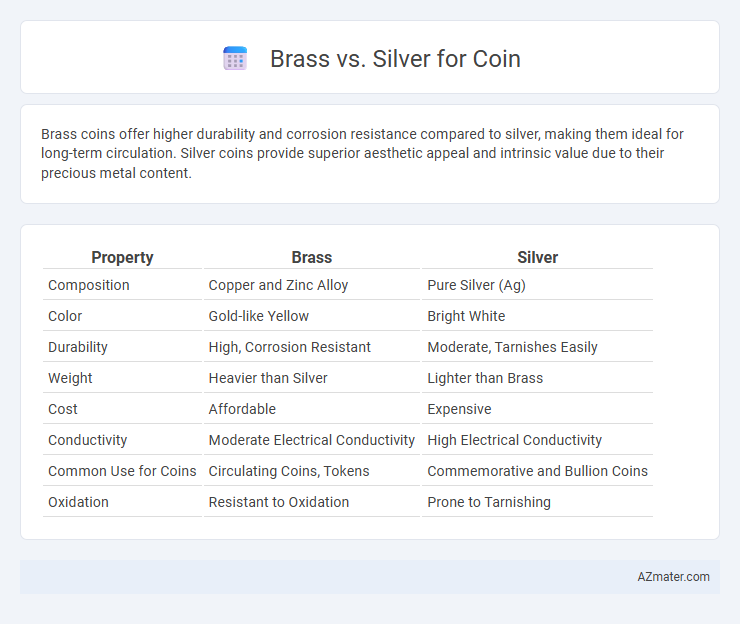Brass coins offer higher durability and corrosion resistance compared to silver, making them ideal for long-term circulation. Silver coins provide superior aesthetic appeal and intrinsic value due to their precious metal content.
Table of Comparison
| Property | Brass | Silver |
|---|---|---|
| Composition | Copper and Zinc Alloy | Pure Silver (Ag) |
| Color | Gold-like Yellow | Bright White |
| Durability | High, Corrosion Resistant | Moderate, Tarnishes Easily |
| Weight | Heavier than Silver | Lighter than Brass |
| Cost | Affordable | Expensive |
| Conductivity | Moderate Electrical Conductivity | High Electrical Conductivity |
| Common Use for Coins | Circulating Coins, Tokens | Commemorative and Bullion Coins |
| Oxidation | Resistant to Oxidation | Prone to Tarnishing |
Introduction to Brass and Silver Coins
Brass coins, composed primarily of copper and zinc, offer durability and corrosion resistance, making them ideal for long-term circulation. Silver coins, traditionally valued for their intrinsic metal content and lustrous appearance, serve both as legal tender and collectible items. The distinct metallic properties of brass and silver influence their usage in coinage, balancing cost, aesthetic appeal, and historical significance.
Historical Usage of Brass and Silver in Coinage
Brass and silver have played significant roles in coinage throughout history, with silver historically favored for its intrinsic value and durability, often used in high-denomination coins across ancient Greece, Rome, and medieval Europe. Brass, an alloy of copper and zinc, gained popularity in the 18th and 19th centuries due to its corrosion resistance and lower cost, becoming common in coins like the British farthing and various modern circulation coins. The transition from silver to brass reflects economic shifts, including the need for more affordable materials during industrialization and periods of silver scarcity.
Physical and Chemical Properties Comparison
Brass, an alloy of copper and zinc, offers higher corrosion resistance and better wear durability compared to silver, which is a softer, pure metal with superior electrical and thermal conductivity. Silver is more malleable and has a higher density (10.49 g/cm3) than brass, which typically ranges from 8.4 to 8.7 g/cm3 depending on its composition. Chemically, brass is more prone to dezincification in acidic environments, while silver resists oxidation but tarnishes when exposed to sulfur compounds.
Durability and Longevity of Brass vs Silver Coins
Brass coins exhibit superior durability compared to silver, as their copper-zinc alloy composition resists corrosion and wear effectively in various environments. Silver coins, while aesthetically valued for their luster, tend to tarnish and scratch more easily, which can reduce their longevity without proper care. Due to its hardness and resistance to chemical reactions, brass maintains its structural integrity longer, making it a preferred choice for coins that require extended circulation life.
Aesthetic Appeal and Visual Differences
Brass coins showcase a warm, golden-yellow hue that often enhances their vintage and decorative appeal, while silver coins present a sleek, bright sheen with a cool, metallic luster that emphasizes clarity and elegance. The distinct color variance between brass and silver allows collectors and designers to choose based on desired contrast and thematic representation in coin aesthetics. Surface oxidation on brass may develop a rich patina over time, whereas silver coins tend to retain a brighter finish but may tarnish with exposure.
Collectibility and Numismatic Value
Brass coins often hold lower numismatic value compared to silver coins due to the intrinsic worth of silver as a precious metal, which enhances their collectibility among investors and collectors. Silver coins are favored in numismatics for their historical significance, rarity, and enduring material value, often resulting in higher market demand and appreciation. Collectors prioritize silver coins for their ability to retain value over time, making them more desirable than brass counterparts in most coin collections.
Cost and Economic Considerations
Brass coins are significantly less expensive to produce than silver coins due to the lower cost of copper and zinc compared to silver, making brass a more economical choice for large-scale minting. The durability and corrosion resistance of brass reduce long-term maintenance costs, enhancing its cost-efficiency for circulation coins. Silver, while valued for its intrinsic worth and visual appeal, entails higher material and production expenses, making it less practical for everyday currency from an economic perspective.
Corrosion Resistance and Maintenance Needs
Brass coins exhibit excellent corrosion resistance due to their copper and zinc composition, which forms a protective patina over time, reducing the need for frequent maintenance. Silver coins, while aesthetically appealing, are more prone to tarnishing and oxidation, requiring regular cleaning to preserve their luster. Choosing brass offers lower maintenance demands and better longevity in various environmental conditions compared to silver coins.
Popularity in Modern Coin Production
Brass and silver both hold significant popularity in modern coin production due to their distinct properties and historical value. Brass is favored for its durability, corrosion resistance, and cost-effectiveness, making it ideal for mass-produced circulation coins. Silver, while less common in everyday currency, remains popular for commemorative and collectible coins due to its intrinsic value and lustrous appearance.
Choosing Between Brass and Silver for Coin Collectors
Collectors often select brass coins for their durability, resistance to corrosion, and lower cost compared to silver coins. Silver coins hold intrinsic value due to their precious metal content, making them a preferred choice for investment and historical significance. The decision between brass and silver depends on whether the collector prioritizes affordability and longevity or metal value and traditional appeal.

Infographic: Brass vs Silver for Coin
 azmater.com
azmater.com